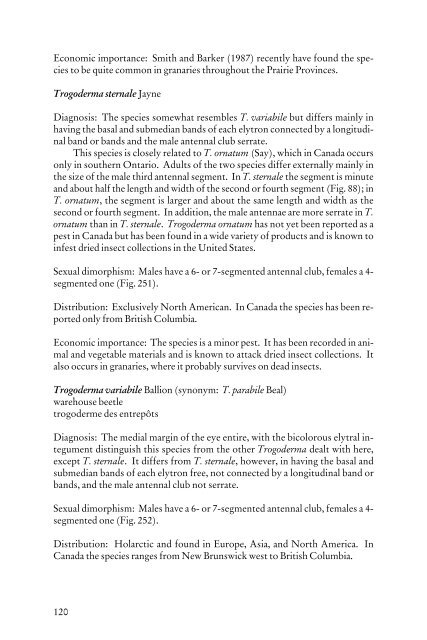Beetles Identification Guide
Beetles Identification Guide
Beetles Identification Guide
Create successful ePaper yourself
Turn your PDF publications into a flip-book with our unique Google optimized e-Paper software.
Economic importance: Smith and Barker (1987) recently have found the species<br />
to be quite common in granaries throughout the Prairie Provinces.<br />
Trogoderma sternale Jayne<br />
Diagnosis: The species somewhat resembles T. variabile but differs mainly in<br />
having the basal and submedian bands of each elytron connected by a longitudinal<br />
band or bands and the male antennal club serrate.<br />
This species is closely related to T. ornatum (Say), which in Canada occurs<br />
only in southern Ontario. Adults of the two species differ externally mainly in<br />
the size of the male third antennal segment. In T. sternale the segment is minute<br />
and about half the length and width of the second or fourth segment (Fig. 88); in<br />
T. ornatum, the segment is larger and about the same length and width as the<br />
second or fourth segment. In addition, the male antennae are more serrate in T.<br />
ornatum than in T. sternale. Trogoderma ornatum has not yet been reported as a<br />
pest in Canada but has been found in a wide variety of products and is known to<br />
infest dried insect collections in the United States.<br />
Sexual dimorphism: Males have a 6- or 7-segmented antennal club, females a 4segmented<br />
one (Fig. 251).<br />
Distribution: Exclusively North American. In Canada the species has been reported<br />
only from British Columbia.<br />
Economic importance: The species is a minor pest. It has been recorded in animal<br />
and vegetable materials and is known to attack dried insect collections. It<br />
also occurs in granaries, where it probably survives on dead insects.<br />
Trogoderma variabile Ballion (synonym: T. parabile Beal)<br />
warehouse beetle<br />
trogoderme des entrepôts<br />
Diagnosis: The medial margin of the eye entire, with the bicolorous elytral integument<br />
distinguish this species from the other Trogoderma dealt with here,<br />
except T. sternale. It differs from T. sternale, however, in having the basal and<br />
submedian bands of each elytron free, not connected by a longitudinal band or<br />
bands, and the male antennal club not serrate.<br />
Sexual dimorphism: Males have a 6- or 7-segmented antennal club, females a 4segmented<br />
one (Fig. 252).<br />
Distribution: Holarctic and found in Europe, Asia, and North America. In<br />
Canada the species ranges from New Brunswick west to British Columbia.<br />
120
















